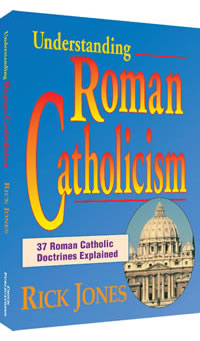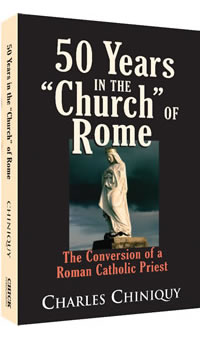Eyewitnesses Testify Shroud of Turin a Fake
Two men, who personally investigated the tomb of Jesus early on the morning of the disappearance of his body, present testimony which seriously jeopardizes the validity of the famous shroud of Turin. Catholic sources claim that the shroud is the burial garment in which the body of Jesus was wrapped prior to burial, bearing his facial image.
John the Apostle reports in THE GOSPEL ACCORDING TO ST JOHN, (Ch. 20) that he and Simon Peter examined the sepulchre themselves immediately after the women reported His body missing.
They did indeed find the customary linen burial wrappings in the tomb. But in addition to the outer wrapping, they also found a facial napkin used to wrap the head. The use of such a napkin would have prevented an image of the face from forming on the outer linens. The Shroud of Turin is a fake.
Relic merchants have provided heavy promotion for the shroud. They claim that the body of Christ was wrapped in a single garment, a "shroud" contained an imprint of facial details and blood stains where it made contact with the body. But this contradicts the double-wrapping described by eyewitnesses John and Peter.
The fraudulent "Shroud of Turin" contains a "shadowy rectangle" on the frontal image which is assumed to be a "modesty cloth" covering the genitals. Here an inner wrapping also obscures detail. If the head had been covered with an inner covering, or "napkin," the detail of the face would have been obscured as well. Obviously the person buried in the Shroud of Turin was not covered in the same type of graveclothes worn by Jesus.
Again we are challenged to accept the Bible as the final authority or the word of an institution with a long history of making the house of God a house of merchandise.
According to the Boston Catechism the shroud would be a second class relic. "First class relics are the bodies or portions of the bodies of the saints. Second class relics consist of articles of clothing or other personal items used by the saints. Third class relics are objects that have touched a first or second class relic." Relic merchants must be diligent in such things.
- See more articles on related topics:
- Catholicism
- Crucifixion of Jesus
- False Religions
- Shroud of Turin
Other Articles from July/August 1984:
More on Catholicism:
Products of Interest:
-

Understanding Roman Catholicism
224 pages
37 Catholic doctrines from the current Catechism are compared with the Scriptures. They're not Christian! -

50 Years in the Church of Rome
368 pages
This classic work shows how this priest began to question Catholic teachings until he became saved, and led his entire parish to salvation. -

Answers To My Catholic Friends
64 pages
A gentle witness you can give Catholics that deals with venerating images, purgatory, where popes go when they die, and more. -

Babylon Religion
224 pages
Learn how a Babylonian goddess became the Virgin Mary. An easy-to-read history of Catholicism's Babylonian origin.



